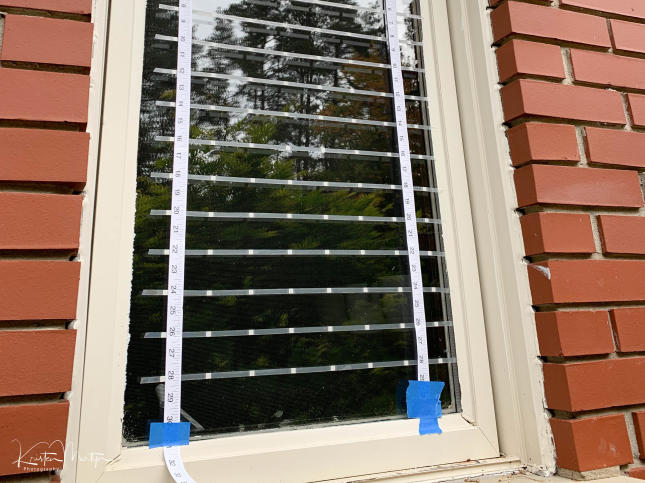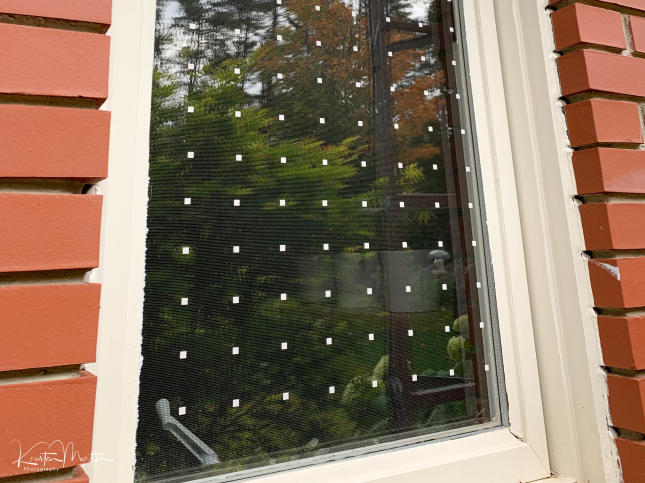How do I Stop Birds from Flying into My Window?
Please note that all of information provided on our website about our products is meant to be informative only. For more information regarding prices and shipping (within Canada only) please visit our store in Barrie (515 Bryne Drive, Barrie, ON), phone us (705) 726-7600 or send us an email [email protected].
There are two scenarios in which birds fly into windows. Read through both of them to determine which is happening at your house as they each have different solutions.
- Scenario 1: A bird flies into your window and has been injured or died as a result. You notice that this occurs year round.
- Scenario 2: You have a bird persistently pecking and flapping around your window. It seems like a healthy bird, but it just won’t leave your window alone. You notice this type of behavior happens only in the spring.
Scenario 1 Explanation and Solutions
Millions of birds die every year flying to windows, because they can’t tell reflections from trees plants and sky. Most of those windows are on houses. Not all windows are equally hazardous. Check to see which of your windows are reflective and closest to the areas when you see the birds when they are active. Collisions happen more frequently during the spring and fall migration periods. Even small windows can be dangerous as many birds fly into small spaces such as tree cavities or between branches. Research has identified solutions to alter birds to windows. The easiest of these involves applying visible markings to the outside of the windows in patterns that the birds can see while requiring minimal glass coverage to keep your view unobscured. Here are some solutions to this problem:

Feathers Left on Glass after Window Strike, Photo by Kristen Martyn


Applying Feather Friendly to Outside of Windows, Photos by Kristen Martyn
Located your Bird Feeders a 3 -OR- 25 Feet Away from Windows: Birds need ample space to fly and escape predators and perceived threats. If your bird feeders are located 3 feet or greater away from your windows when they try and escape they may hit your windows. Move your feeders back until they are at least 25 feet from your windows. You can also move them closer to your window (3 feet or less is ideal) this way they can't build up enough speed to hurt themselves should a window strike occur.
- Use Window Decals to Alert Birds to the Presence of Windows: Apply a decal to your window to alert the bird that there is a reflection on the glass. There are a number of products on the market for this and professional companies that will install decals on large windows and buildings with a lot of windows. WBU Barrie sells Feather Friendly and WindowAlert decals a great product that work well for smaller windows. Feather Friendly is a full surface solution. Using a row of these small decals spaces 2" x 2" apart is a proven method to reduce window strikes. The WindowAlert decals have a UV coating that alerts birds to a window. Birds see in UV so the decals glow to display the window; however to us they appear like clear stickers. These decals need to be applied every 9-12 months as the UV coating fades in sunlight. They also need to be spaced a maximum of 3 feet apart. Each decal covers a maximum 3 foot by 3 foot area, closer spacing is recommended.
- Keep Your Blinds Down and Partially Closed: While not a 100% effective solution. Keeping your blinds down may cut down on the reflection of your windows and signal to birds that a window is present.
Feather Friendly® Window Markers: Bird collisions with residential glass surfaces account for a significant number of bird deaths annually - especially during migration seasons. To allow for birds to 'see the glass' and not collide, subtle visible markers must be applied to exterior glass surfaces in problem areas. This new, highly effective, ‘Do-It-Yourself’ Kit is now available from Feather Friendly® Technologies. It allows you to apply the same solution at home that has proven to be successful in thousands of square feet of commercial building installations. Each 100’ roll protects a glass surface of 2.5’ x 6.5’ (30” x 80”) or 16’ square feet. See bottom of page for a video on how to install Feather Friendly Tape and come in store to see it in use and just how unobtrusive it really is!
Available in packages of 1 or 3 rolls, each kit of Feather Friendly comes with: 100’ roll (1 or 3) of Feather Friendly Residential Marker-Pattern Tape; Measuring Tapes (2); Installation Instructions.
 WindowAlert: Now you can protect wild birds from striking windows. WindowAlert is a low-tack decal that may be applied to home and office windows. The decals contain a component which brilliantly reflects ultraviolet sunlight. This ultraviolet light is invisible to humans, but glows like a stoplight for birds. Birds have vision that is up to 12 times better than that of humans. WindowAlert decals help birds see windows and avoid striking the glass. WindowAlert come in a package of 4 decals. WBU Barrie carries several types of WindowAlert designs hummingbirds, butterflies, leaf medley and maple leafs.
WindowAlert: Now you can protect wild birds from striking windows. WindowAlert is a low-tack decal that may be applied to home and office windows. The decals contain a component which brilliantly reflects ultraviolet sunlight. This ultraviolet light is invisible to humans, but glows like a stoplight for birds. Birds have vision that is up to 12 times better than that of humans. WindowAlert decals help birds see windows and avoid striking the glass. WindowAlert come in a package of 4 decals. WBU Barrie carries several types of WindowAlert designs hummingbirds, butterflies, leaf medley and maple leafs.
Scenario 2 Explanation and Solutions
Since windows reflect images during the spring time when male birds are defending territories and attracting mates a window can appear like a rival male bird. When a male bird sees it’s reflection in a window or reflective surface it believes it is seeing another competing male bird in its territory and begins an attack. This typically involves flapping and pecking at a window, sometimes for hours on end. It is not only annoying but can be harmful to the birds. A male bird may waste lots of energy attacking its reflection which can leave it exhausted and susceptible to predators. This behavior is typically only a problem in the spring during mating season and eventually will stop. The birds that typically engage in this behavior are Northern Cardinals, Northern Mockingbirds and American Robins. There are two ways to help prevent this behavior...one is to eliminate the reflective qualities of the glass window so it does not act as a mirror, the other is to create a physical barrier between the bird and the window. A light colored or white material placed against the inside of the glass may help to reduce the reflection enough to stop the attacks. This can be newspaper, a sheet, a white window cleaner or other material. Interior vertical blinds (that are light in color) with the slats half open or closed may help. A dark room or dark drapes will actually increase the reflection and encourage more attacks. Here are some other solutions to this problem:
Cover the Reflective Surface: To stop this behavior you will need to cover the reflective surface the bird is attacking. Window decals do not work in this situation. You will need to cover the entire area. Sometimes once you cover the spot they are attacking they may move onto the next reflective surface and so on. So you may need to cover more than one window. There are many options for covering your window one of the cheapest ways is to cover them with newspaper. It may not look nice but it will solve the problem. The good news is when mating and nesting is over so is this problem so typically your windows only need to be covered until late June or early July at the latest (typically this behaviour is over much sooner near the end of May).


